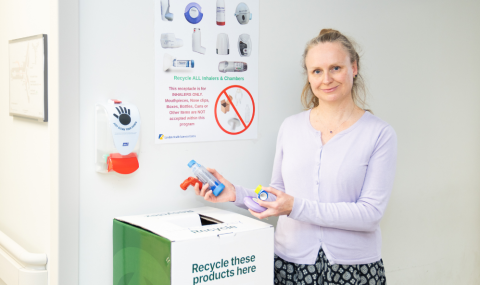Molecular Imaging and Theranostics, formerly Nuclear Medicine, uses small amounts of radioactive materials called radiotracers that are typically injected into the bloodstream, inhaled or swallowed. The radiotracer travels through the area being examined and gives off energy in the form of gamma rays which are detected by a special camera and a computer to create images of the inside of your body. Molecular Imaging and Theranostics scans are used to diagnose and sometimes treat disease.
How to book an appointment
Molecular Imaging and Theranostics, formerly Nuclear Medicine, scans are by pre-booked appointment only. Your preparations for the scan will depend on the body part that is being imaged. You will receive detailed instructions with your booking.
Diabetic devices
Diabetic management devices including glucose sensors, transmitters, receivers and insulin pumps can be damaged by radiation and magnetic fields. Glucose sensors, transmitters, receivers or insulin pumps must be removed immediately prior to your test. Insulin pumps may be restarted following the test. Glucose sensors cannot be reinserted, you must use a new sensor following the test. If you would prefer to reschedule your test, please let us know. For any questions regarding your device, please contact the manufacturer of your device.
What can I expect?
- You may be asked to change into hospital attire.
- Other than the discomfort of a needle stick, Molecular Imaging and Theranostics, formerly Nuclear Medicine, scans are painless.
- There is a large time range for Molecular Imaging and Theranostics (formerly Nuclear Medicine) scans, from hours to days, please feel free to ask when you receive your booking how long you can expect for your test.
Is it safe?
- Yes. The amount of radioactivity given in a Molecular Imaging and Theranostics (formerly Nuclear Medicine)) procedure is very similar to that of a CT scan.
- If you are pregnant or think you might be, please consult with your doctor.
- If you are breastfeeding, please contact the Molecular Imaging and Theranostics (formerly Nuclear Medicine) department prior to your arrival.
Will it make me radioactive?
- Yes. Although the amount of radioactivity is small, you will be considered to be radioactive. The radioactivity naturally decays (becomes less over time), and is also excreted from the body, depending on which radiotracer is given.
- If you plan on entering an airport or crossing a border, be sure to let the Technologist know.
How to access your Molecular Imaging and Theranostics images
For information on accessing your Molecular Imaging and Theranostics (formerly Nuclear Medicine) images, visit Accessing Your Diagnostic Images.
Is it your child coming for a test?
The Medical Imaging Child Life Program strives to meet the psychosocial and emotional needs of children and youth throughout their health-care journeys. They help them adjust to and understand hospitalization, medical procedures, illness and injury. They are commonly involved with procedures such as Molecular Imaging and Theranostics (formerly Nuclear Medicine) scans.
How to find Nuclear Imaging (Molecular Imaging and Theranostics)
Hours of operation and phone number for Nuclear Medicine (Molecular Imaging and Theranostics) at Victoria Hospital
Outpatient Hours of Operation are Monday to Friday from 7:30 a.m. (0730) to 4:30 p.m. (1630)
Contact phone number is 519-685-8500 extension. 52985
Hours of operation and phone number for Nuclear Medicine (Molecular Imaging and Theranostics) at University Hospital
Outpatient Hours of Operation are Monday to Friday from 8:00 a.m. (0800) to 3:45 p.m. (1545)
Contact phone number is 519-685-8500 extension. 37081
Directions to Nuclear Medicine (Molecular Imaging and Theranostics) at University Hospital
- Enter through the main entrance at the front of the hospital.
- Take the main elevators to the third floor and follow signs to Nuclear Medicine Room C3−206.
Directions to Nuclear Medicine (Molecular Imaging and Theranostics) at Victoria Hospital
- Enter the hospital off Baseline Road, turn right onto Dagnone drive in front of the Thames Valley Children´s Centre.
- Pass the north tower, Building B, and park in the visitor parking garage (P8) on the left.
- Take the parking garage elevators to Level 2. Enter the hospital across the glass walkway.
- Walk past Patient Registration and past the elevators, Nuclear Medicine reception room B2−340 is located on your right.


